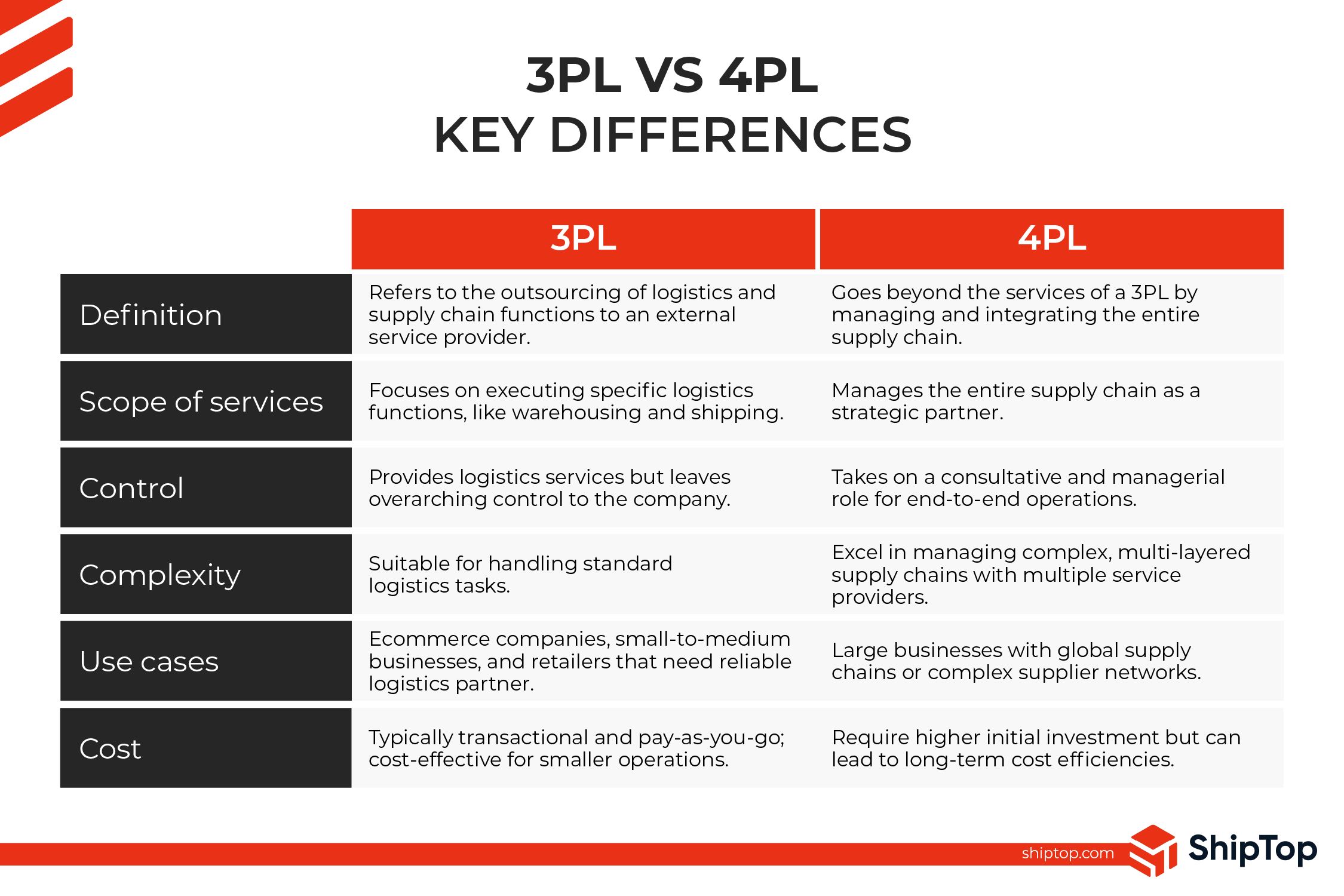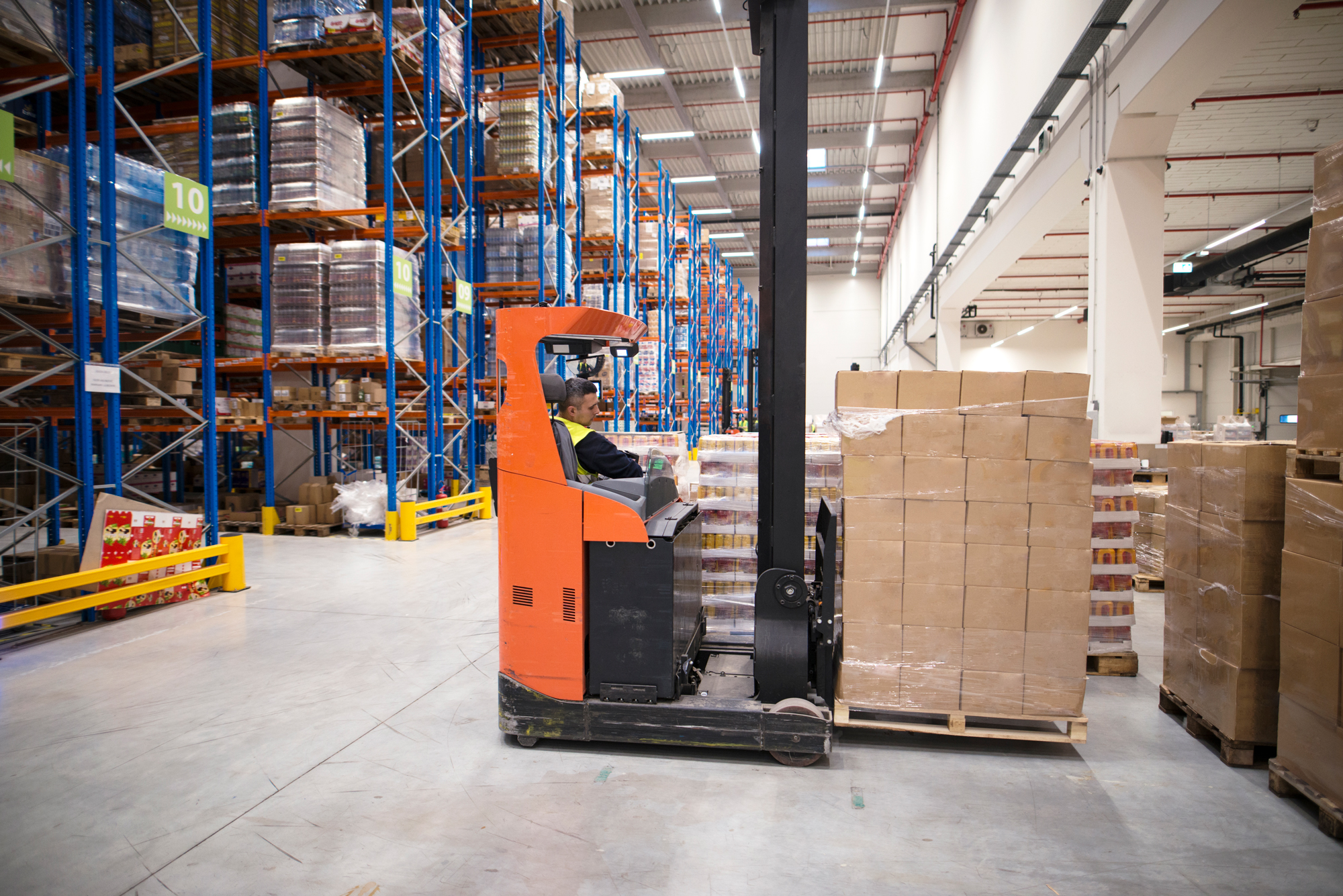As companies grow and become more complex, they often need to outsource some of their operations to third-party logistics (3PL) providers or fourth-party logistics (4PL) providers.
At a high level, 3PL refers to companies that handle the execution and day-to-day logistics operations. 4PL refers to companies that take on more of a consultative role in supply chain management — they oversee 3PLs and try to optimize your entire logistics operation.

You still probably have some questions, so let’s resolve this whole 3PL vs 4PL debate by digging deeper into their definitions and use cases.
What is 3PL?
Third-party logistics (or 3PL) refers to a company that provides outsourced logistics services to businesses for part or all of their supply chain management. 90% of companies featured in the Fortune 500 use 3PL.
These providers specialize in handling specific logistics activities, such as transportation, warehousing, and order fulfillment, to help businesses streamline their operations.
Here are some common use cases:
- E-commerce companies looking for warehousing and order fulfillment solutions.
- Small-to-medium businesses that need reliable transportation and shipping.
- Retailers outsourcing reverse logistics for returns and exchanges.
Common services provided by 3PLs include:
- Transportation management: Coordination and execution of shipping, including freight forwarding and carrier selection.
- Warehousing services: Storage of goods, inventory management, and stock rotation.
- Order fulfillment: Picking, packing, and shipping customer orders.
- Freight consolidation: Combining smaller shipments into larger loads to optimize transportation costs.
- Reverse logistics: Managing returns, exchanges, and recycling or disposal of products.
- Customs brokerage: Assistance with international shipping, including navigating customs regulations and documentation.
- Cross-docking and transloading: Transferring products directly from inbound to outbound transport — or changing modes of transportation — to ensure the package gets where it needs to be on time and within budget.
What is 4PL?
Fourth-party logistics (or 4PL) goes beyond the services of a 3PL by managing and integrating the entire supply chain.
A 4PL provider essentially serves as a supply chain manager, bringing together the client company, 3PLs, and other partners to design and manage the overall logistics process. The 4PL provider acts as an integrator that oversees the entire logistics network.
While 3PLs handle execution and fulfillment, 4PLs oversee and orchestrate the bigger picture. 4PLs assemble the best 3PL and transportation providers for each part of the client’s supply chain.
Here are some common use cases:
- Large enterprises with global supply chains that require centralized management.
- Companies in industries like manufacturing or pharmaceuticals with complex supplier networks.
- Businesses looking to implement data-driven supply chain optimization strategies.
Common services provided by 4PLs include:
- Supply chain strategy design: Developing and implementing comprehensive logistics strategies to improve efficiency.
- Vendor management: Coordinating and managing relationships with multiple 3PLs, carriers, and suppliers.
- Technology integration: Implementing and managing advanced technologies, such as ERP (Enterprise Resource Planning) and TMS (Transportation Management Systems), for enhanced supply chain visibility.
- End-to-end supply chain oversight: Monitoring and controlling all supply chain processes from procurement to delivery.
- Cost management: Analyzing and optimizing logistics costs across the supply chain.
- Risk management: Identifying and mitigating risks in the supply chain.
- KPI reporting: Tracking and reporting performance metrics to ensure service quality and efficiency.
- Consultative role: Offering continuous process improvement recommendations based on data analytics.
Key differences between 3PL and 4PL
Here is another table with some additional comparison points to help you distinguish between 3PL and 4PL providers.
| Service Aspect | 3PL | 4PL |
| Asset Ownership | Owns warehouses, transportation fleets, and inventory | Does not own assets, oversees and manages 3PLs |
| Scope of Services | Warehousing, transportation, and inventory management | Broader supply chain integration and optimization |
| Level of Control | Less control and visibility for shippers | Greater control over the supply chain for shippers |
| Focus Areas | Logistics execution | Overall supply chain strategy and optimization |
| Customization | Standardized services | Highly customized solutions |
| Pricing Model | Transactional (based on activities handled) | Strategic (based on value-added) |
| Technology | Proprietary technology | Integrates systems across multiple 3PLs |
| Expertise | Operational expertise | Robust supply chain management expertise |
Which model is better for your business?
Deciding between 3PL and 4PL depends on your business’s unique needs and capabilities.
Here are some key factors to consider:
1. Business size
Small businesses may benefit more from 3PL, which offers basic warehousing and shipping services. As you grow, you may eventually outgrow 3PL.
Larger businesses often need the advanced supply chain capabilities of a 4PL. However, small and mid-sized companies can also utilize 4PL if they have complex logistics needs.
2. Supply chain complexity
Companies with simple, linear supply chains can be well-served by a 3PL provider.
Businesses with multi-node, global supply chains will benefit from the specialized expertise of a 4PL. The 4PL can optimize and coordinate complex logistics operations across many facilities, geographies and modes of transport.
3. Technology capabilities
3PLs offer basic logistics technology like WMS. However, they need the sophisticated IT integration capabilities of a 4PL.
A 4PL can provide complex logistics visibility, predictive analytics, optimization, and other tech-enabled services. This allows for greater supply chain automation, agility and cost efficiency.
4. Control and oversight
With 3PL, you directly manage logistics operations, while outsourcing the execution.
4PL relinquishes control over execution and management. This hands-off approach provides convenience but can also entail risks around accountability.
5. Cost considerations
3PL contracts are generally more affordable for basic transportation and warehousing needs.
4PL has higher service fees but can drive larger long-term cost savings through supply chain optimization. The ROI depends on your scale, complexity, and logistics spending.
How ShipTop can help?
ShipTop is a Canadian-based fulfillment center that offers both 3PL and 4PL solutions to businesses of all sizes. Our team has over 10 years of experience managing complex supply chains and providing optimized logistics services.
As a 3PL, we provide warehousing, distribution, transportation, and freight forwarding services. Our nationwide fulfillment centers are equipped with state-of-the-art inventory and order management systems. We handle storage, picking, packing, shipping, and returns on your behalf. Our transportation network allows us to provide cost-effective LTL, FTL, parcel, and intermodal shipping across North America.
As a 4PL, we are a single point of contact to manage your entire logistics operation. Our logistics experts design, implement, and optimize your supply chain strategy. We have experience selecting the right 3PL partners, negotiating rates, managing contracts, overseeing operations, and providing real-time analytics. This allows you to focus on your core business while we focus on your logistics.
Weigh your business needs and supply chain complexity to determine if a 3PL or 4PL model is better. Reach out for a consultation and our team will help you select the right logistics model for your business.






